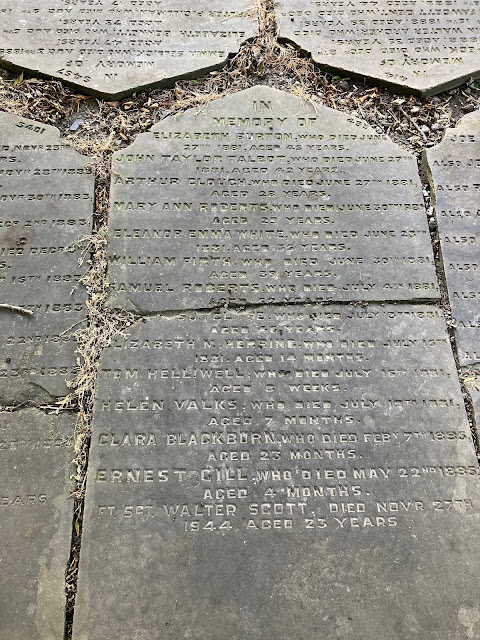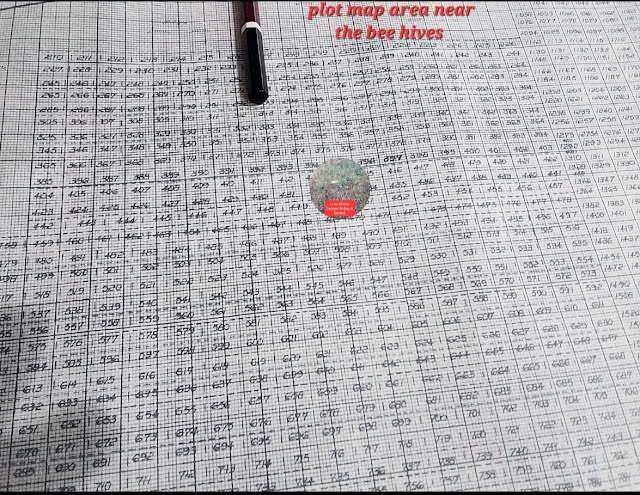It's Tombstone Tuesday! Today's tombstone was photographed by Laura Cleaver for the Find A Grave website, at the Leeds General Cemetery in Leeds, Yorkshire England.
"SAMUEL ROBERTS, WHO DIED JULY 4th 1881
AGED 52 YEARS"
I was surprised to find my 2nd great grandfather's gravestone on the Find A Grave website, and it is the first overseas tombstone I have found. Samuel Roberts, the son of John Roberts and Hannah Westerman, was born about 1829 in Leeds, Yorkshire, England. He married Mary Anne Stott on 21 March 1853 in Leeds. She was the daughter of James Stott and Sarah Heseltine, born 29 October 1831 in Leeds and died in March 1912 in Settle, Yorkshire. Samuel and Mary Anne had ten children, three went to the United States including my great grandfather John Peter Bawden Roberts (1865 - 1925) who immigrated to Beverly, Massachusetts in 1915 via Ellis Island.
Samuel raised his family in the slums of Yorkshire. He worked as a laborer in factories, and according to several census records he was described as an "engine man" or "engineer". This means he operated machinery in the factory. He lived in the Woodhouse section of Leeds, in 1871 his residence was 25 Woodhouse Street, and in 1881 his residence was 17 Rhodes Buildings. His death record lists his occupation as "engine tender".
Samuel died on 3 July 1881 (according to the death record) and was buried on July 6th. His gravestone lists the death on July 4th. The informant was his son Arthur. There are 14 people listed on the gravestone, all unrelated (I checked). That seemed strange to me, so I did some investigating online. What I found was surprising to me as an American, but not so strange to Europeans.
Leeds in the 19th and early 20th century was a factory town. The slums were horrific. I have an oral history recorded on a cassette tape, and narrated by my grandmother, Bertha Roberts (1897 - 1990). Her stories reminded me of books like Angela's Ashes, by Frank McCourt. The city was overcrowded with laborers and their families. The cemeteries were overcrowded, too.
Samuel was buried in a "guinea grave" at the Leeds General Cemetery, also known as Woodhouse Cemetery or Woodhouse Lane Cemetery. A guinea grave was a grave for 12 - 20 people, and the family paid one "guinea" for this priviledge. According to a Facebook forum for "Leeds Family History" a guinea was 21 shillings or a little more than a pound in today's money. Paupers would be buried in a common grave for free. Thank goodness for these informal genealogy groups on Facebook! Through this group I was referred to another group "Friends of Woodhouse Cemetery", where I learned more history of this burial ground. Members of these groups gave me a great history of the guinea graves, and of the slums in the Woodhouse neighborhood.
UPDATE: After this blog post was published online on March 12, a woman named Yvonne Sutton and her sister Linda Goodwin read the post and then took more photos of Samuel's gravesite. Scroll to the bottom to see what she posted on the "Friends of Woodhouse Cemetery" Facebook group!
The sad thing about the Leeds General Cemetery is that it belongs to the University of Leeds, who removed almost all the gravestones to create a greenspace for their campus known as St. George's Field. Most of the surrounding area known as Woodhouse is part of the university, too, and the addresses I have from census records for Samuel are now new university housing. Originally there were over 80,000 burials in this cemetery, most without memorial stones in guinea graves. Very few stones are still there, and the chapel is still standing, so it is a miracle that this stone with Samuel Robert's name survives.
As an American we are not accustomed to the practice of cemeteries without "perpetual care". I have seen in Spain that bodies are placed in rented niches for a few years, which are later cleaned out and then the niche is rented to another family. In England the graves are not "perpetual" either, and especially paupers' graves or common graves such as these guinea graves.
I have not visited the city of Leeds. I'm hoping to someday see the church where the Roberts family worshipped (All Soul's Hook Memorial), the streets, and this cemetery. I can find records of other family members in this cemetery, but this is the only one with a photograph of a surviving tombstone.
This house stood on Rhodes Buildings where Samuel Roberts lived in Leeds, around the time of his death. Thank you to the Leeds Libraries Leodis website https://www.leodis.net/
Updated photos, with kind permission from Yvonne Sutton and Linda Goodwin:
This photo and the maps below will help me to locate the gravesite. The gravestones were all moved, and many buried, to another location, to form the university parkland.
For the truly curious:
Samuel Roberts at Find A Grave: https://www.findagrave.com/memorial/226194619/samuel-roberts
"Friends of Woodhouse Cemetery" at Facebook: https://www.facebook.com/groups/1765932953450945
The University of Leeds maintains a website with a database of burials at the Leeds General Cemetery. Here is a link to the record for Samuel Roberts: https://explore.library.leeds.ac.uk/special-collections-explore/546233/roberts_samuel?selection=Leeds%20General%20Cemetery%20Burial%20Registers%20Index&archiveLocationOfOriginals=433&resultLength=60&resultOffset=7&fbclid=IwAR3f7Jdc43AcKSycGhOQBGoQ1MQfW_Zgi9BvHM-jS_zYEwycpr1iWnaoEn4
Surname Saturday blog post for the ROBERTS family: https://nutfieldgenealogy.blogspot.com/2014/03/surname-saturday-roberts-of-leeds.html
This link is part four of a transcription my grandmother's audio tape, describing her childhood in Leeds: https://nutfieldgenealogy.blogspot.com/2010/05/amanuensis-monday-berthas-audio-tape.html
------------------------
To cite/link to this blog post: Heather Wilkinson Rojo, "Samuel Roberts, buried 1881, Leeds, Yorkshire, United Kingdom - Tombstone Tuesday", Nutfield Genealogy, posted March 14, 2023, ( https://nutfieldgenealogy.blogspot.com/2023/03/samuel-roberts-buried-1881-leeds.html: accessed [access date].







Thanks for touching on the nuances of overseas cemeteries. I've heard of instances in Germany where the burial spaces are "rented," similar to your explanation in Spain. Remarkable.
ReplyDeleteAmazing post, and what a gravestone! We are used to the luxury of space in the U.S. (at least outside of large metro areas), which offer the possibility of perpetual care. Heartbreaking to imagine how difficult some of our ancestral research would be if gravestones were similarly removed here.
ReplyDelete